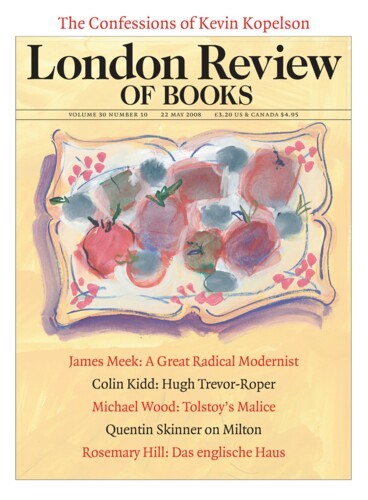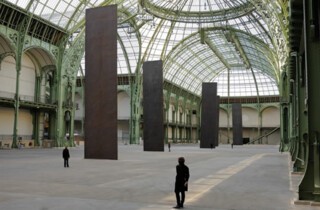There is a general recognition of a ‘late style’ in music and literature – a turn to a vital asperity towards the end of a life of composition à la Beethoven or Yeats – but less so in visual art, at least among prominent Modernists. One exception is Matisse, who, in his late cutouts, returned with gusto to ‘the purity of means’ that marked his early Fauve paintings. With a temporary piece at the Grand Palais in Paris that also combines simplicity and grandeur, Richard Serra anticipates a late style of his own.
Just a year ago a retrospective at the Museum of Modern Art charted the rigorous development of Serra’s sculptural language, from a direct engagement with rubber and lead in his early pieces to an elaborate turning of steel plates in his celebrated arcs, ellipses and spirals of the last three decades. An early example of this later idiom, Clara-Clara, first exhibited in a Serra retrospective at the Centre Pompidou in 1983, has now reappeared on its original site in the Tuileries. (The director of the Pompidou, Alfred Pacquement, curator of that show, is also curator of the two pieces presently in Paris.) Set along the grand axis from the Louvre to the Arc de Triomphe, Clara-Clara consists of two opposed curves of steel, 33 metres long and four metres high, one of which leans towards the central line, the other away. Placed near the place de la Concorde on the esplanade designed by Le Nôtre for Louis XIV, Clara-Clara is baroque in its own manner, playing boldly with the strict geometry of the grand axis. In this way it also initiates the promenade to the new piece at the Grand Palais, which Serra, in an acknowledgment of the ambulatory sociability featured in Impressionist painting as well as the directed movement of the viewer through his own work, has titled Promenade. (It can be seen until 15 June.)
Constructed for the 1900 World Fair, the Grand Palais has a stone façade of mixed styles typical of the Belle Epoque, but the hall that rises above it is cleanly expressed in steel and glass, a triumph of confident engineering, also characteristic of the time, that complements, in its horizontality, the verticality of the Tour Eiffel down the Seine. The cruciform space of the Palais is vast; the nave alone is 200 metres long, 50 metres wide, and 35 metres high, with a floor of 13,500 square metres and a volume of 450,000 cubic metres. Faced with this immensity, Serra first thought to mark out the ground with blocks (such as the ones seen in the Tate Gallery in 1992) so as to compress and control the volume.* But he soon realised that this would not only duck the challenge of the nave but also relinquish its greatest asset – the length of its height – and so he opted for vertical plates instead. The questions then became: how big, how many, and how arrayed? Only so much can be predetermined; as with Mondrian, intuition and experience inform the geometries of his work – along with the limits, which Serra likes to push, of engineering.
Serra decided on plates 17 metres high and four metres wide; absolutely vertical, they are anchored only shallowly in the ground, and nothing supports them at the surface. This size turned out to be an excellent match of technical necessity – the plates are about the largest that can now be milled – and aesthetic scale: at just under half the height of the nave, they hold their own against the architecture but do not overwhelm the viewer (only about 15 centimetres thick, they appear almost elegant). Yet this resolution of size still left the questions of number and placement, and there could be no trial run. Serra calculated that 100 feet might be the right interval to create a rhythm that would at once articulate the architecture and motivate the viewer; more plates might interfere with the former and/or intimidate the latter, while fewer might make the ground feel a little arid. This formula makes for five plates over the 200 metres of the nave, with one placed directly under the cupola, and this is what Promenade consists in.
The particulars of placement remained, however, and here Serra was cued by the axis of the nave, to which all the plates are strictly perpendicular. To scatter the plates would be to lose the power of this strong line; to overlap them would be to destroy the centre in another way. So Serra decided to set the plates at a very slight angle (1.69 degrees) from the axis: some are positioned on the central line at the bottom and 20 inches away at the top, while others are 20 inches off the central line at the bottom and plumb at the top. These deviations create, with simple means, a great tension; one feels drawn through the piece as through a slalom course. Yet this energy might feel forced if the rhythm were only one of alternation, so here again Serra mixed things up: from the Champs Elysées side to the Seine side, the pattern of lean vis-à-vis the centre is in-in-away-away-in. As with Clara-Clara, then, the theme of the axis is played with variations, and the apertures never fail to surprise wherever one is along the axis. Side views also allow one to see the plates both as individuals and as a group; again as with Mondrian, there is a political dimension to this dialogue between the one and the several, difference and identity, which is also underscored by the peaceable assembly of clustered viewers as a key element of the piece.
We cannot help but associate the plates with other kinds of marker and support: steles, columns and so forth. It is often characteristic of a late style that a return to first principles is simultaneously a reach toward new associations. Serra here recovers the fundaments of his ‘prop’ pieces of the 1960s and, in doing so, reasserts his utter commitment to radical abstraction (when I propose Mondrian, he counters with Malevich). But other connections are opened up as well: at the unveiling of Promenade, Serra acknowledged his debt to precursors in sculpture such as Brancusi and Giacometti, who were also embraced by the French, and one feels their presence here too. Yet the associations are not restricted to abstraction or even to Modernism, or rather both categories are revealed to be less presentist or amnesiac than they are often assumed to be. For example, Promenade stages a direct encounter between two moments of industrial modernity a century apart. With its vegetal ornament, the structure of the Grand Palais is marked by Art Nouveau, which Benjamin once described as a ‘mediumistic line language’ that strives ‘to win back’ the new forms of industrial building ‘for art’; much modern sculpture enacts a related compromise between industry and art. However, with Serra (and peers like Carl Andre) there is no such ‘winning back’, only a forging forward of industrial structure as an expanded language of sculptural production in its own right, and this is made clear by Promenade.
Built for exhibition, the Grand Palais also calls up the great train stations of the time; the Gare, now Musée, d’Orsay across the Seine is its exact contemporary. Such halls and stations were seen as the cathedrals of the 19th century, and they often carry on the churchly grammar of columns, arches, ribs and naves. In its very abstraction Promenade reveals this archaeology of historical structures; one might argue that it points to the ancient form of the basilica in the palais as well. Indeed, if Clara-Clara evokes the baroque history of its surroundings, Promenade does the same with the Gothic lineage of its context. This is ‘site specificity’ in an extended sense, and, though Promenade might well feel at home elsewhere, France would be wise to hold onto a piece that does so much to carry forward its own signal traditions.
Send Letters To:
The Editor
London Review of Books,
28 Little Russell Street
London, WC1A 2HN
letters@lrb.co.uk
Please include name, address, and a telephone number.


